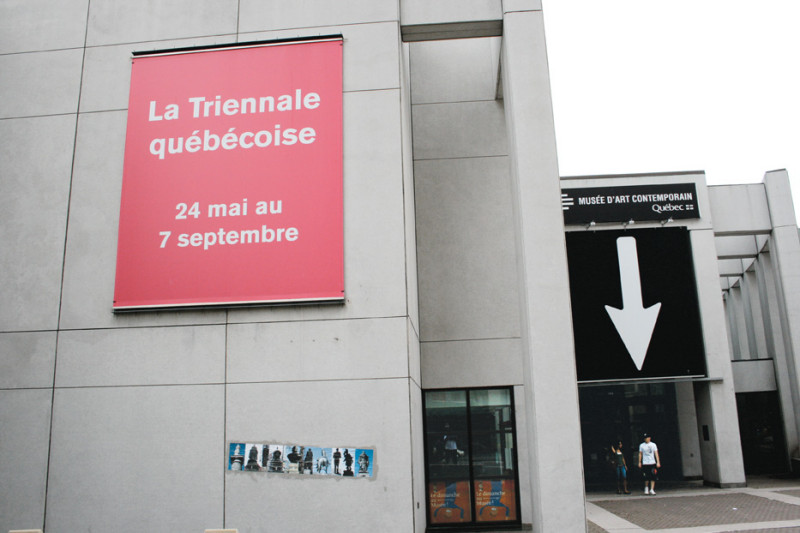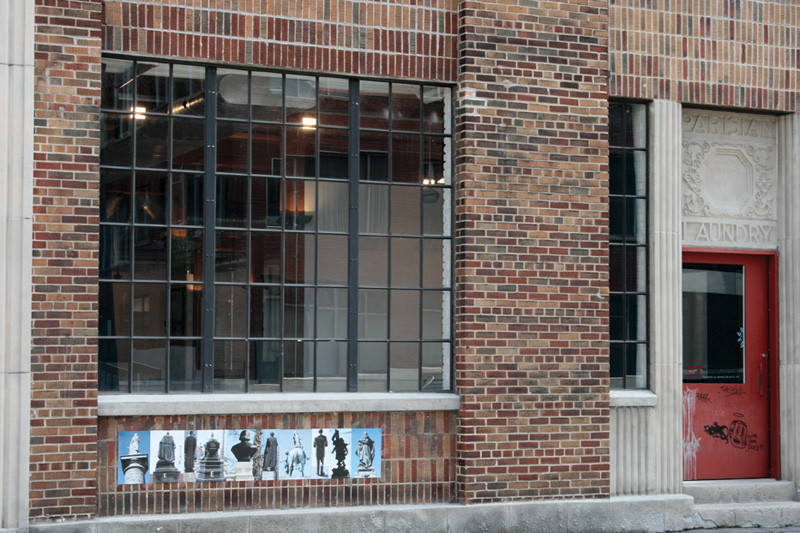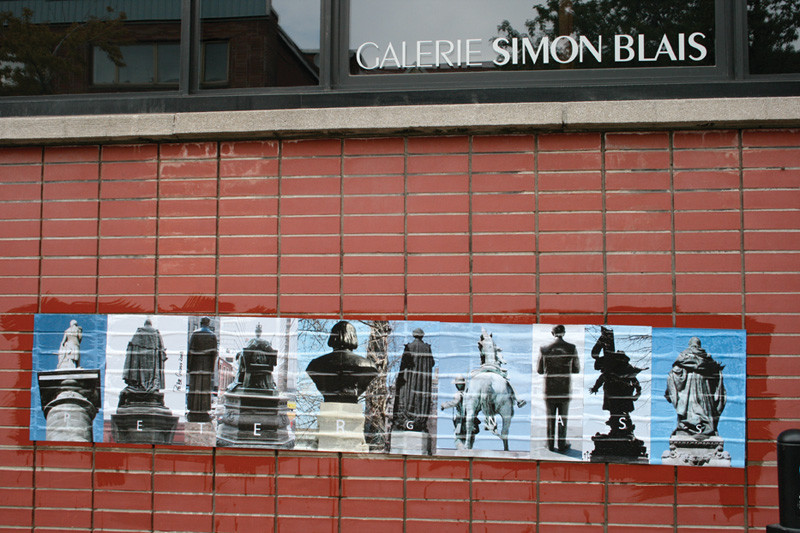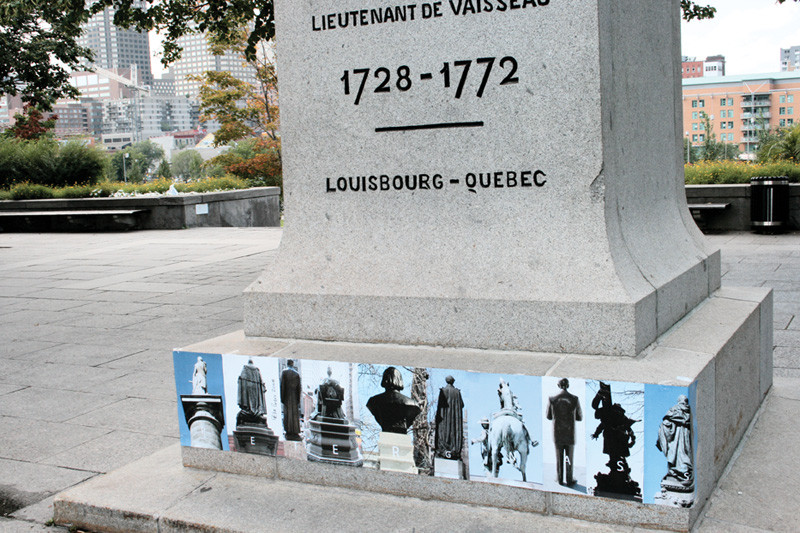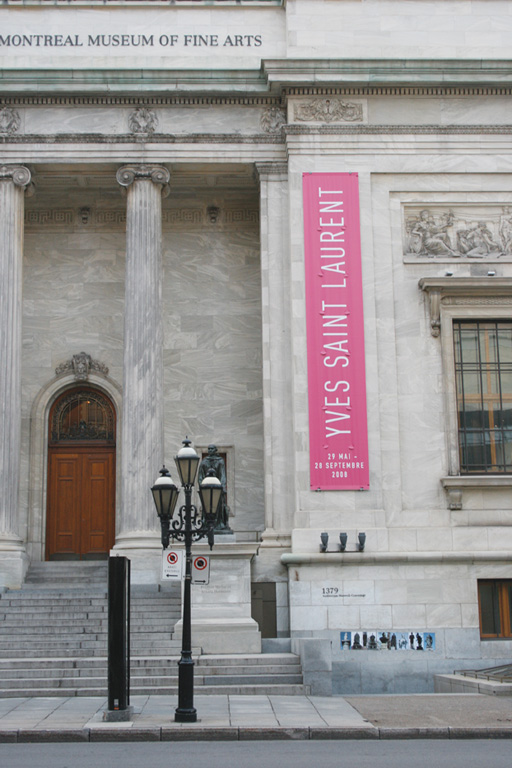by Patrice Loubier
Last autumn, copies of a poster featuring photographs of monuments in downtown Montreal appeared without warning on the façades of a dozen cultural sites in the city. The Nelson column, the bust of Octave Crémazie, and the equestrian statue commemorating the Boer War, among others, briefly burst onto the scene at the Musée d’art contemporain, the Belgo Building, and the Parisian Laundry. Although the fly posting bore neither text nor legend, this impetuous gesture was not anonymous, since letters discreetly superimposed on the photographs formed a fragmented signature of the author, Peter Gnass1; nevertheless, the intervention was intended to be a visual enigma calling upon passersby to notice how the image of the monument had been subtly displaced.
Gnass first undermines the monuments’ uniqueness: while a monument stands alone in the place assigned to it, the poster showed many, juxtaposed in the promiscuity of a tight framing. Reproduced on paper in horizontal format, at eye level, they are deprived of the heroic elevation of traditional statuary. Finally, these “deposed” sculptures are metaphorically released from their site, an itinerancy that reiterates the view in close-up or low angle, making the statue, cut from its pedestal and its environment, into a detail. This decontextualization encourages us to try to recognize and situate them, look at them with fresh eyes, thus reviving our perception of familiar sights that, perhaps, we no longer saw through force of habit. Yet an even more significant gap results from the pictures: Gnass shows these statues, ostensibly erected in the public space for us to view, as they are turning their backs on us.
A monument, as we know, materializes and celebrates the representation that a state, nation, or group makes of itself and its history; it calls upon the community to cultivate the memory that is represented. Inspired by figures of power and important notables, from New France (Vauquelin), to the British regime and Confederation (John A. Macdonald), to modern Quebec (Jean Drapeau), covering all of Quebec history, these sculptures are, in the fullest sense, monuments. Despite the authority with which such monuments impose themselves on our view and the permanence that they claim, they are never anything but the expression of an interpretation – partial in both its senses – of history. The momentary ideology that they embody exposes them ineluctably to “extinction,” or even to controversy.2 For instance, a likeness of Brother André or of an Ultramontane ecclesiast such as Mgr Ignace Bourget no longer speaks to us today with the clarity that it had in the past. It is this vulnerability of the monument to becoming outdated (even though it is supposed to avert this by the force of its material presence and the eloquence of its symbolic challenge) that is revealed by La multitude déchue. The viewpoints privileged by Gnass accentuate this message by showing statues that do not, properly speaking, look at us – an obsolescence reinforced by the rather stuffy grandiloquence of their poses. Thus, the intervention also acknowledges a way of writing history and cultivating memory, itself past its time.
This state of decay through which the past acknowledges itself as past is even more obvious because Gnass (re)presents these monuments in places where contemporary creativity is disseminated, on the façades of galleries and artist-run centres. But he also posts them on museums, where works that win their wagers are conserved, received by history, and offered for the public’s enjoyment; at these sites, the itinerant monuments no longer seem so displaced, as if their artistic status has, or momentarily regains, a residual sparkle. But the artist less pays tribute to the monument than quotes it and casts aspersions on its dignity to better mobilize it. Fly posting – the “wildness” of the gesture, the hasty collage, and the economy of means of the intervention – strongly contrasts with the pomp and official character associated with commemorative sculpture.
In contrast to a Wodiczko, who reanimates the monument in situ through projections that reveal its “latent” discourse, Gnass interferes with its image, displacing it, reducing it to detail, and inserting it in a series. It is a means of symbolic debunking that demeans the vainglory of the monument, but also gives it new impetus at the ground level of daily life.
Thus, as is Gnass’s wont, the work playfully reveals the preponderance of the point of view over the object, of perspective over substance – in other words, of the influence of the gaze, always situated, never transcendent, over any claim to knowledge of the thing “in itself.” Here, the phenomenon is less perceptual than political: Gnass’s posting highlights our indifference, or our sometimes uneasy relationship, with the patrimony; it also leads us to question the permanence of the tacit “we” with which the monument challenges us, and to think about what these ghostly silhouettes, encountered by chance as we walk through the city, still say to us and, even more, what they don’t say and leave in shadow.
Translated by Käthe Roth
Peter Gnass lives and works in Montreal and France. A multidisciplinary artist who has long worked in the public sphere, he has created a number of urban works based on a critical reflection on the art system. His works are included in numerous public collections. The Galerie de l’UQAM mounted a retrospective exhibition in 2004.
Patrice Loubier is an art historian and independent critic: he is interested in intervention art and furtive practices. He has co-curated a number of events, including Orange (2003), Manif d’art 3 (2005), and Espace mobile (Montreal, 2008). He currently teaches at the Université du Québec à Montréal.

